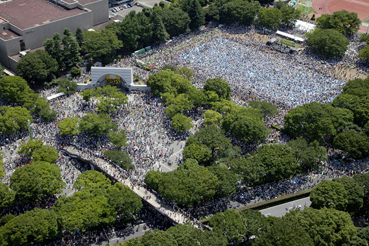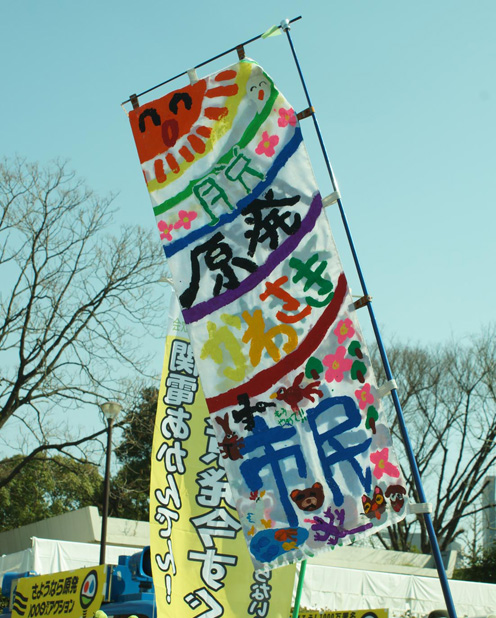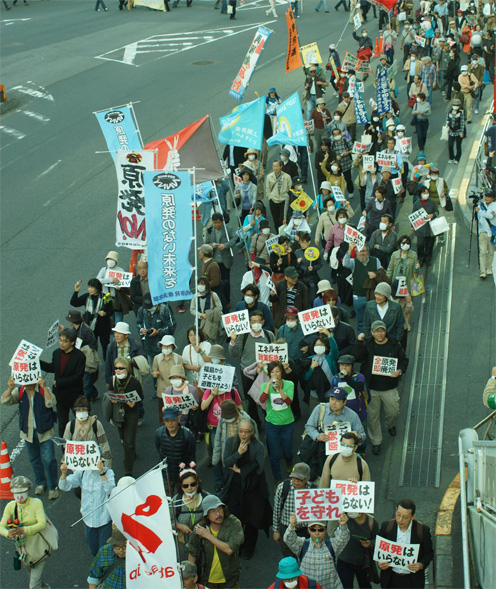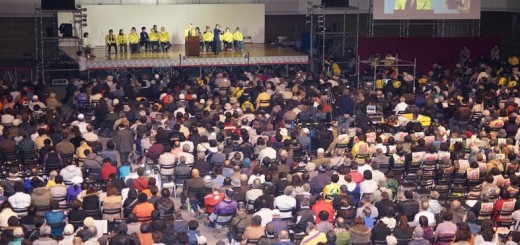Second list of signatures signed by anti-nuclear citizens submitted; total number of signatories rises to 8.38 million Nuke Info Tokyo No. 158
Introduction
 |
|
| 170,000 people gathered for the Sayonara (Good-bye to) Nuclear Power Plants rally on July 16, 2012. (cc) NODA Masaya / JVJA |
On November 26, 2013, as tension mounted in Japan over the controversial secrecy law to prevent leaks of state secrets, an anti-nuclear citizens’ group aiming to collect signatures from 10 million people handed the second round of collected signatures to the Deputy Speaker of the House of Representatives and the Vice President of the House of Councilors, as well as to the Cabinet Office. As of November 20, the group named “Sayonara (Good-bye to) Nuclear Power Plants” had collected a total of 8,378,701 signatures, including those contained in the first round, which were submitted in June 2012. During and after the submission of the signatures, the group members held a meeting in the Diet building and a rally on the signature campaign in Hibiya Park, and then set out on an anti-nuclear march in downtown Tokyo.
In the meeting held in the Upper House members’ office building prior to the submission of the signatures, Satoshi Kamata, one of the core promoters of the event, gave a speech that took into consideration the Special Secret Protection Bill which had been railroaded through the Lower House ad hoc committee the same morning. He emphasized the significance of the meeting, saying “It is extremely meaningful to hold this kind of meeting in this place on the day when the Japanese society is facing a historic crossroads where we must decide on whether or not to return to pre-war fascism.” He went on to say that the fact that as many as 8.3 million or 8.4 million signatures have been collected shows, in a tangible way, how deep the ordinary citizens’ anti-nuclear sentiment is. Chikako Chiba of the Fukushima Conference for a Nuclear Phaseout appealed to the audience for support by saying “The cries of the disaster-stricken people are screams demanding compensation from the government and TEPCO, neither of which has shown any sign of fulfilling their responsibilities.”
Kenzaburo Oe, Japan’s renowned Nobel Prize-winning author, is one of the core promoters of this signature-collecting campaign. Led by Oe and other promoters, the group headed for the Diet amid a situation where many protesters against the secrecy law had already surrounded the Diet building. The group handed the signatures directly to the Upper House vice president and the Lower House deputy speaker. They then proceeded to the Prime Minister’s Office but were refused entry and were forced to abandon the plan to submit the signatures to the prime minister. Instead, the group delivered them to the Cabinet Office. In 2012, the group members entered the Prime Minister’s Office and handed the signatures to the Chief Cabinet Secretary.
Following these actions, the group held a rally for the signature campaign in Hibiya Park from 6:30pm.
Oe, one of the speakers at the rally, said, “The people gathered here are engaged in various anti-nuclear activities with the same passion, the same sense of reality, and the same vision for the future, as those of the demonstrators surrounding the Diet building in protest against the secrecy law.” Keiko Ochiai, a writer, translator, feminist and manager of Crayon House – a book store specializing in children’s and women’s literature, said “For us, there is no choice but to move forward by uniting the thoughts and feelings of the signatories with those of the sufferers of the nuclear disaster in Fukushima Prefecture.” Another speaker, Hisae Sawachi, a non-fiction writer, stressed that her opposition to the enactment of the secrecy law stemmed from the viewpoint of protecting the lives of the children in the future. Makoto Sataka, a political and economic commentator and magazine publisher, reminded the audience that Prime Minister Shinzo Abe had said earlier that things were under control, but in fact he was unable to control even the heads of the local governments backed by the ruling Liberal Democratic Party in the public hearing held in Fukushima Prefecture. Needless to say, it would be impossible for the prime minister to control Sataka and other anti-nuclear protesters, he added.
Shin Sugo, a third-generation Japanese-Korean and business operator, warned the demonstrators by saying, “The government deceived the public by forging a myth that nuclear power plants were safe. Now they are trying to deceive us by creating another myth that radioactivity is safe. The government is working hard to enact the secrecy law to conceal the truth from the public. Don’t allow yourselves to be deceived.”
Ryuichi Sakamoto, a musician, activist, composer, record producer and writer, and Hiroaki Koide, assistant professor at Kyoto University Research Reactor Institute, sent written messages to the rally along with their signatures. In the message, Sakamoto said, “A river of tears has been flowing at the bottom of our hearts since that day (when the nuclear accident occurred in Fukushima in March 2011), but we are nonetheless determined to go on living here.” Koide said this would be the last chance for Japan to make a course correction, and that this was a turning point for this country.
Following the rally, the participants launched a protest march in the direction of Ginza, but it was just around that time that the secrecy bill was forced through the Lower House plenary session. After the march, some of the participants headed for the Diet and joined the people protesting against the railroading of the controversial bill through the Diet.
(Ikuko Kuwabara, CNIC)
 |
 |
 |
| Photos taken at the Sayonara (Good-bye to) Nuclear Power Plants rally, on June 2, 2013. | ||



